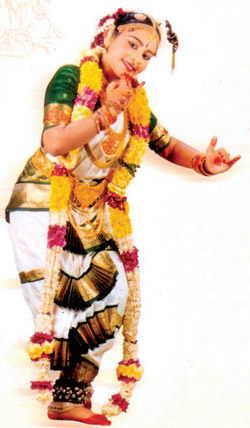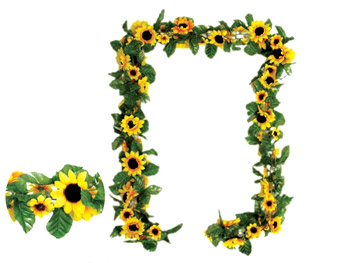Garland-making as unique art
Subashini Pathmanathan
Garland is one of the important elements for dancing mainly in the
classical and folk-dance forms. Naturally, garland making is a unique
art, for temple idol decoration.
|

A dancer with a garland |
For daily poojas, abishekas and festivals the garlands are changed
according to the poojas. A garland once used cannot be reused for
another pooja. For each pooja new garlands are used to decorate the
idols. Different varieties of flowers are used in the temples. Colourful
flowers are used in dance. Some flowers are not used for the temple
poojas. While using flowers for dance, such restrictions are not
applicable.
Decorating the temple idols is a unique art. Certain varieties of
flowers are avoided according to Hindu traditions and rituals. Even
certain variety of leaves and grass are used for certain Gods.
For Lord Ganesha, Arukam grass garlands are used. Similarly, for Lord
Vishnu’s pooja Thulsi leaf garlands are used; besides flower garlands
are also used. Similarly for Lord Ganesha, Vilva leaves are used for
poojas and archanas. For Hanuman worship betel leaf garlands are used.
However, different colourful flowers and variety of flower petals are
also used, for garland making as well as poojas in temples.
Mainly white and attractive jasmine flowers, different colourful
lotus petals such as pink, yellow, blue and white lotus, colourful
sunflowers and green leaves are also used for garland making.
Similarly orange colour kanagaparam flowers, yellow colour kondal
flowers, and pichai flowers are normally used in the garland making. The
garland makers not only use the flowers but also they use the matured
flower buds while making the garlands.
According to Hindu Tamil tradition traditional beautiful thick
colourful garlands are used to welcome dignitaries and important guests.
These garlands are decorated with gold and silver thread to give a
rich look to the garlands.
Even among all the main seven Indian Classical dance forms Bharatha
Natyam, Kuchupidi, and Mohini Attam, the maximum amount of flowers, and
flower garlands are used for hairdressing. Flower garlands for dance
look almost the same as the Hindu bridal hairdressing garland
decoration. Yet some basic differences are there for garland
decorations. The flower garlands for dance should not be too thick, as
used in general purposes like temple poojas and welcome garlands.
Bharatha Natyam evolved out of the temple dance known as Sathir. The
temple dancers were called devadasis then and they considered themselves
as the brides of the gods. Therefore the Bharatha Natyam artistes still
decorate themselves as brides. Even if they decorate themselves as the
Hindu brides, they cannot dance with heavy flower decorations.
|

Sunflower garland |
Almost all dancers follow the same hairdressing techniques of the
Hindu traditional brides, but the method of making garlands for stage
dancers are different from the Hindu bride’s garlands. It is important
for the dances that the garlands should be very light for the stage
performances.
Generally the Hindu brides and the Bharatha Natyam dancers wear the
Rakodi at the back end of
the uchipattam. A round shaped garland is used around the Rakodi.
This is called Rakodi malai. That is also made by the flower buds.
Similarly hair is plaited for both the brides as well as dancers.
The plaited hair is covered with a flower garland called Chadanaagam.
It ends with Chadai kuncham made out of flowers. However, for Bharatha
Natyam the Chadanaagam is made out of beautiful patterns of flowers tied
with the dry banana tree layers, because the banana tree layers are
lighter than the soft hardboard. For Hindu brides the Chadanagam is
often tied with soft and flexible hardboard, which is quite heavier,
than the banana tree layers.
In between the Chadanagam and the Rakodi, the flowers are filled up
in the hairdressing.
Earlier white colour flowers and orange kanagamparam flowers were
used.
However, the present generation dancers like to have different
colourful flowers to match their costumes.
Earlier the dancers used natural flowers which provided more
aesthetic essence and value to the art. However, today according to the
saree colours, the dancers use artificial flowers. These flowers are
made out of cloth, plastic, and regiform. These flowers could be used
more than once for numerous programs whenever flowers are scarce.
Using artificial flowers are not a healthy method but they are not
heavy like natural flowers. Still most of the dedicated dancers prefer
to have the natural flowers instead of artificial flowers. Some adopt
important and special items like Aandal, Meenakshi Kalyanam, and
Meenakshi Thaladu special garland decorations. |



